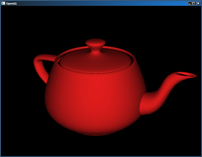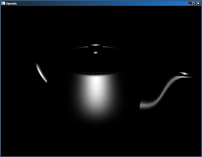CS 5610/6610 - Spring 2019 - Interactive Computer Graphics
Project 3 - Shading
In this project we will introduce simple lighting and shading.
Requirements
The requirements of this project are separated into three steps. You can verify your implementation at the end of each step.
- Step 1: Display triangles
- Generate buffers for the triangle vertices of an .obj file.
- Draw the triangles using either
glDrawArraysorglDrawElements.
 flat shaded teapot
flat shaded teapot - Step 2: Normal buffer
- For shading the triangles we will need surface normals. Generate a normal buffer.
- The vertex shader should transform the normals using inverse transpose of the camera transformation matrix (exlucing projection).
Notice that the part of the surface facing up (y-direction) is green and the part facing right (x-direction) is red. The rest of the surface appears blue. Note that negative color values are clamped to [0,1]. surface normal as color
surface normal as color
- Step 3: Blinn shading
- Implement Blinn shading in the fragment shader, including ambient, diffuse, and specular components.
- The material properties can be hard-coded as constants or uniform parameters.
- The light position can be hard-coded as a contant or a uniform parameter.
 ambient + diffuse
ambient + diffuse specular
specular ambient + diffuse + specular
ambient + diffuse + specular
Additional Requirements for CS 6610 Students
- Rotate the light around the object center using two angles.
- When the CTRL key is down, left mouse click and drag should adjust the light rotation around the object.
 lighting from a different direction
lighting from a different direction
Optional
- Display the light as a separate object.
_